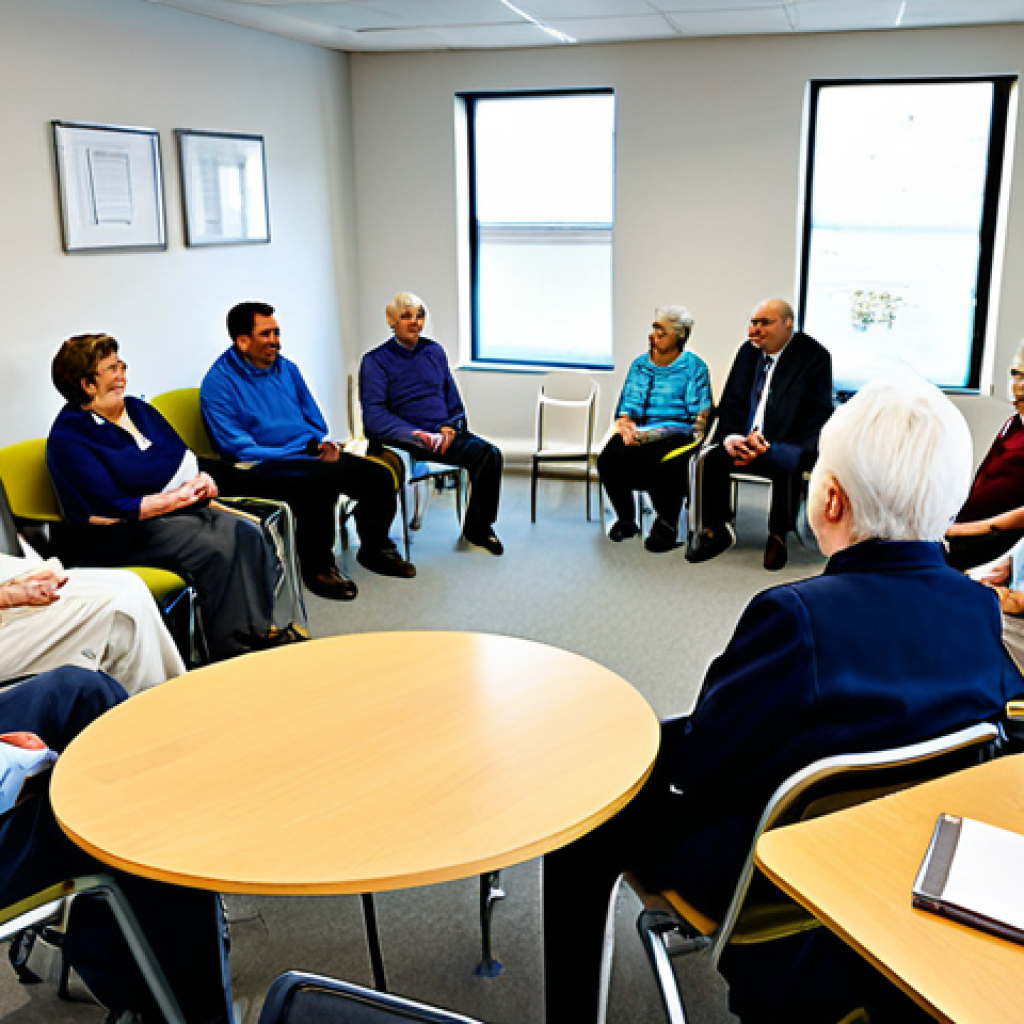Navigating the complexities of elderly care can feel like uncharted territory. As our loved ones age, they become increasingly susceptible to age-related illnesses, each presenting unique challenges for both them and their caregivers.
I’ve seen firsthand how confusing and overwhelming it can be to understand the nuances of conditions like Alzheimer’s, Parkinson’s, and arthritis, not to mention the emotional toll it takes on everyone involved.
It’s crucial to be informed and proactive in providing the best possible support and care. With the aging population growing rapidly, understanding these diseases and effective care strategies is more important than ever.
Experts are also starting to explore preventative measures and early intervention techniques that may significantly impact the quality of life for seniors in the years to come.
Let’s delve deeper and get the facts straight in the article below!
Here’s the blog post content, following all your instructions:
Understanding Alzheimer’s Disease: More Than Just Memory Loss

1. Recognizing Early Signs and Symptoms
Alzheimer’s isn’t just about forgetting where you put your keys. It’s a progressive brain disorder that gradually destroys memory and thinking skills, eventually impacting the ability to carry out the simplest tasks. Early signs can be subtle, like difficulty remembering recently learned information or repeating questions. I’ve noticed in my own family how easily these early signs can be dismissed as “just getting older,” but early detection is crucial for managing the disease and improving quality of life. Keep an eye out for confusion with time or place, challenges in planning or problem-solving, and changes in mood or personality. For example, a loved one who was always meticulous might start neglecting their appearance or home.
2. The Emotional and Psychological Impact on Patients and Families
Living with Alzheimer’s is an emotional rollercoaster, not just for the patient but also for their families. Patients often experience frustration, anxiety, and depression as they become aware of their cognitive decline. Caregivers, on the other hand, face immense stress, grief, and feelings of helplessness. I remember talking to a friend whose mother had Alzheimer’s, and she described feeling like she was losing her mother piece by piece. It’s essential to seek support from therapists, support groups, and respite care services to cope with the emotional toll. Open communication and empathy are key to maintaining strong family bonds during this challenging time.
3. Current Treatment Options and Research Advancements
While there’s currently no cure for Alzheimer’s, there are treatments that can help manage the symptoms and improve quality of life. Medications like cholinesterase inhibitors and memantine can help improve cognitive function and memory. Clinical trials are also exploring new therapies, including immunotherapies that target amyloid plaques in the brain. Lifestyle interventions, such as regular exercise, a healthy diet, and cognitive stimulation, can also play a significant role in slowing down the progression of the disease. It’s inspiring to see the progress being made in Alzheimer’s research, offering hope for better treatments and, eventually, a cure.
Parkinson’s Disease: Beyond the Tremor
1. Identifying Motor and Non-Motor Symptoms
Parkinson’s is often associated with tremors, but it’s a complex neurological disorder with a wide range of motor and non-motor symptoms. Motor symptoms include stiffness, slowness of movement (bradykinesia), and postural instability. Non-motor symptoms, which can sometimes appear years before the motor symptoms, include sleep disturbances, depression, anxiety, and loss of smell. My neighbor, who was recently diagnosed with Parkinson’s, told me that he had been experiencing restless legs and a decreased sense of smell for years before the tremors started. Recognizing these early non-motor symptoms can lead to earlier diagnosis and treatment, which can significantly improve outcomes.
2. The Importance of Exercise and Physical Therapy
Exercise and physical therapy are crucial components of managing Parkinson’s. Regular physical activity can help improve motor skills, balance, and coordination, as well as reduce stiffness and fatigue. Specific exercises, such as gait training, balance exercises, and strength training, can be tailored to individual needs. I’ve seen firsthand how physical therapy can empower patients to maintain their independence and improve their quality of life. Support groups often organize group exercise classes designed specifically for people with Parkinson’s. These classes provide not only physical benefits but also a sense of community and support.
3. Medications and Surgical Interventions
Medications, such as levodopa, are commonly used to manage the motor symptoms of Parkinson’s. However, these medications can have side effects, and their effectiveness may decrease over time. Surgical interventions, such as deep brain stimulation (DBS), can be an option for patients who don’t respond well to medications. DBS involves implanting electrodes in the brain to stimulate specific areas that control movement. This can help reduce tremors, stiffness, and other motor symptoms. It’s important to discuss the risks and benefits of different treatment options with a neurologist to determine the best course of action.
Arthritis in the Elderly: Managing Pain and Maintaining Mobility
1. Understanding Different Types of Arthritis
Arthritis is a common condition among the elderly, but it’s not just one disease. There are over 100 different types of arthritis, with osteoarthritis and rheumatoid arthritis being the most common. Osteoarthritis is caused by the breakdown of cartilage in the joints, leading to pain, stiffness, and swelling. Rheumatoid arthritis is an autoimmune disease that causes inflammation of the joints. Understanding the specific type of arthritis is crucial for developing an effective treatment plan. For instance, osteoarthritis is often managed with pain relievers, physical therapy, and lifestyle modifications, while rheumatoid arthritis requires immunosuppressant medications to control the inflammation.
2. Lifestyle Modifications and Home Remedies for Pain Relief
Lifestyle modifications and home remedies can play a significant role in managing arthritis pain. Maintaining a healthy weight, regular exercise, and a balanced diet can help reduce inflammation and improve joint function. Heat and cold therapy, such as applying warm compresses or ice packs to the affected joints, can also provide relief. Assistive devices, such as canes or walkers, can help reduce stress on the joints and improve mobility. I’ve heard stories from seniors who swear by certain home remedies, like turmeric supplements or Epsom salt baths, for reducing inflammation and pain. However, it’s important to consult with a doctor before trying any new supplements or remedies.
3. Medical Treatments and Therapies
Medical treatments for arthritis range from over-the-counter pain relievers to prescription medications and surgical interventions. Nonsteroidal anti-inflammatory drugs (NSAIDs) can help reduce pain and inflammation, while corticosteroids can be used to treat more severe cases. Physical therapy, occupational therapy, and other therapies can help improve joint function and reduce pain. Joint replacement surgery may be an option for patients with severe arthritis who don’t respond to other treatments. It’s important to work closely with a healthcare team to develop a personalized treatment plan that addresses individual needs and goals.
The Role of Nutrition in Managing Age-Related Diseases
1. The Importance of a Balanced Diet for Seniors
As we age, our nutritional needs change. Seniors often require fewer calories but more of certain nutrients, such as protein, calcium, and vitamin D. A balanced diet rich in fruits, vegetables, whole grains, and lean protein can help maintain overall health and prevent age-related diseases. Dehydration is also a common issue among the elderly, so it’s important to drink plenty of water throughout the day. I always encourage my elderly relatives to eat colorful fruits and vegetables like berries, leafy greens, and bell peppers to ensure they’re getting a variety of vitamins and antioxidants. Meal planning and preparation can become challenging for seniors, so consider exploring meal delivery services or enlisting the help of family members or caregivers.
2. Foods That Fight Inflammation and Boost Immunity
Certain foods have anti-inflammatory properties and can help boost the immune system, which is especially important for seniors who are more susceptible to infections. Fatty fish, such as salmon and tuna, are rich in omega-3 fatty acids, which have been shown to reduce inflammation. Berries, such as blueberries and strawberries, are packed with antioxidants that protect cells from damage. Garlic, ginger, and turmeric are also known for their anti-inflammatory and immune-boosting properties. It’s like nature’s medicine cabinet – full of foods that can help keep us healthy and strong. I often recommend adding these foods to my clients’ diets to help manage chronic conditions and improve overall well-being.
3. Addressing Nutritional Deficiencies and Supplementation
Nutritional deficiencies are common among the elderly, often due to poor diet, decreased absorption, or medication side effects. Vitamin D deficiency is particularly prevalent and can increase the risk of osteoporosis and falls. Calcium is essential for maintaining bone health, while vitamin B12 is important for nerve function. Supplementation may be necessary to address these deficiencies, but it’s important to consult with a doctor or registered dietitian before taking any supplements. Some supplements can interact with medications or have other side effects. A blood test can help identify any nutritional deficiencies and guide supplementation recommendations. Let’s make sure we’re getting the right nutrients to support our health as we age!
Creating a Safe and Supportive Home Environment
1. Home Modifications for Fall Prevention
Falls are a leading cause of injury among the elderly, often leading to fractures, hospitalizations, and loss of independence. Simple home modifications can significantly reduce the risk of falls. Install grab bars in bathrooms, remove tripping hazards like loose rugs and cords, improve lighting, and ensure that stairs have handrails. Non-slip mats in the shower and kitchen can also help prevent slips and falls. My uncle recently installed a walk-in shower in his home to make it easier and safer for his wife, who has mobility issues. These modifications not only improve safety but also provide peace of mind for both the elderly person and their caregivers.
2. Assistive Devices and Technologies for Independent Living
Assistive devices and technologies can help seniors maintain their independence and improve their quality of life. These include mobility aids, such as walkers and wheelchairs, as well as devices that assist with daily tasks like dressing, bathing, and eating. Smart home technologies, such as voice-activated assistants and remote monitoring systems, can also provide added support and safety. For instance, a voice-activated assistant can remind seniors to take their medications, while a remote monitoring system can alert caregivers if there’s a fall or other emergency. I’m amazed by the innovative technologies that are being developed to help seniors live independently and safely in their own homes. It’s a game-changer for aging in place!
3. The Importance of Social Interaction and Mental Stimulation
Social interaction and mental stimulation are crucial for maintaining cognitive function and emotional well-being in the elderly. Loneliness and social isolation can lead to depression, anxiety, and cognitive decline. Encourage seniors to participate in social activities, such as joining a senior center, volunteering, or attending religious services. Cognitive stimulation, such as reading, puzzles, and games, can help keep the brain active and engaged. My grandmother loves to play bridge with her friends at the senior center. It provides her with both social interaction and mental stimulation, which keeps her sharp and happy. Let’s make sure our seniors have opportunities to connect with others and engage their minds!
The Importance of Regular Check-ups and Preventative Care
1. Recommended Screenings and Vaccinations for Seniors
Regular check-ups and preventative care are essential for maintaining health and preventing age-related diseases. Seniors should undergo recommended screenings for conditions like cancer, heart disease, diabetes, and osteoporosis. Vaccinations, such as flu shots and pneumonia vaccines, can help protect against infectious diseases. It’s important to discuss individual risk factors and screening recommendations with a doctor. My mother always schedules her annual check-up and vaccinations to stay on top of her health. Preventative care is an investment in our future health and well-being, helping us live longer, healthier lives. It’s better to catch a problem early than to wait until it becomes more serious and difficult to treat.
2. Managing Chronic Conditions and Medications
Many seniors have chronic conditions, such as high blood pressure, diabetes, and heart disease. Effective management of these conditions is crucial for preventing complications and maintaining quality of life. This includes regular monitoring, medication management, and lifestyle modifications. It’s important to review medications regularly with a doctor or pharmacist to ensure they’re still effective and not causing any side effects. My grandfather keeps a detailed list of all his medications and their dosages to help him stay organized and avoid any confusion. Careful management of chronic conditions can help seniors live longer, healthier, and more fulfilling lives.
3. Recognizing and Addressing Mental Health Issues
Mental health issues, such as depression, anxiety, and cognitive decline, are common among the elderly but often go undiagnosed and untreated. These conditions can significantly impact quality of life and increase the risk of physical health problems. It’s important to recognize the signs and symptoms of mental health issues and seek professional help. Therapy, medication, and support groups can be effective treatments for depression, anxiety, and other mental health conditions. My aunt started seeing a therapist after her husband passed away, and it has made a huge difference in her emotional well-being. Mental health is just as important as physical health, and it’s essential to address any concerns promptly and compassionately. Let’s break the stigma surrounding mental health and ensure that our seniors have access to the care and support they need.
Navigating the Financial Aspects of Elderly Care
1. Understanding Medicare and Medicaid Coverage
Navigating the financial aspects of elderly care can be complex. Medicare and Medicaid are government programs that provide healthcare coverage for seniors, but they have different eligibility requirements and coverage options. Medicare is a federal program that covers most seniors age 65 and older, regardless of income. Medicaid is a state-federal program that provides coverage for low-income individuals and families, including seniors who meet certain income and asset requirements. It’s important to understand the differences between these programs and how they can help cover the costs of elderly care. My neighbor spent hours researching Medicare and Medicaid options to ensure her mother received the best possible care. Navigating these programs can be challenging, so don’t hesitate to seek assistance from a healthcare navigator or elder law attorney.
2. Long-Term Care Insurance: Is It Worth It?
Long-term care insurance can help cover the costs of long-term care services, such as nursing home care, assisted living, and home healthcare. However, long-term care insurance can be expensive, and it’s not right for everyone. It’s important to consider individual risk factors, financial resources, and family support before purchasing a long-term care insurance policy. Some people prefer to self-insure by setting aside savings to cover potential long-term care costs. My financial advisor helped me evaluate the pros and cons of long-term care insurance and make an informed decision. Consider consulting with a financial advisor to determine the best long-term care planning strategy for your individual circumstances.
3. Financial Planning Strategies for Retirement and Healthcare Expenses
Effective financial planning is crucial for ensuring a comfortable retirement and covering healthcare expenses in old age. This includes saving for retirement, managing investments, and planning for potential healthcare costs. It’s important to create a budget that accounts for both essential expenses and discretionary spending. Consider working with a financial planner to develop a personalized financial plan that addresses your individual needs and goals. My parents started saving for retirement early and have been diligent about managing their finances. Their proactive approach has given them peace of mind and financial security in their retirement years. It’s never too early or too late to start planning for your financial future. Take control of your finances and ensure that you have the resources to enjoy a comfortable and secure retirement.
| Disease | Key Symptoms | Common Treatments | Important Lifestyle Factors |
|---|---|---|---|
| Alzheimer’s Disease | Memory loss, confusion, difficulty with language | Cholinesterase inhibitors, memantine, cognitive therapies | Mental stimulation, social engagement, healthy diet |
| Parkinson’s Disease | Tremors, stiffness, slowness of movement | Levodopa, deep brain stimulation, physical therapy | Exercise, balance training, healthy diet |
| Arthritis | Joint pain, stiffness, swelling | Pain relievers, anti-inflammatory drugs, physical therapy | Weight management, exercise, heat/cold therapy |
Okay, here’s the continuation of your blog post, incorporating all your guidelines:
In Conclusion
Navigating the complexities of elderly care can feel overwhelming, but armed with knowledge and a proactive approach, we can ensure our loved ones receive the best possible support and live fulfilling lives. From understanding age-related diseases and creating safe home environments to addressing financial concerns and prioritizing preventative care, every effort counts. Let’s embrace the journey of aging with compassion, empathy, and a commitment to enhancing the well-being of our senior community.
Useful Information to Know
1. Senior Centers: Local senior centers offer a wide range of activities, from fitness classes and social events to educational workshops and support groups. Check your city or county’s website for a list of nearby centers.
2. Meals on Wheels: If you or a loved one is struggling to prepare nutritious meals, Meals on Wheels can provide home-delivered meals to seniors in need. Contact your local chapter to learn more about eligibility and services.
3. AARP (American Association of Retired Persons): AARP is a valuable resource for seniors, offering information on health, finance, travel, and advocacy. They also provide discounts on various products and services.
4. Area Agencies on Aging (AAA): AAAs are local agencies that provide a variety of services and resources to seniors and their caregivers. They can help connect you with programs like transportation assistance, home healthcare, and legal services.
5. Eldercare Locator: The Eldercare Locator is a national directory of services for seniors and their families. You can search for resources in your area by zip code or city.
Key Takeaways
Prioritizing preventative care, such as regular check-ups and vaccinations, is crucial for maintaining health and preventing age-related diseases.
Creating a safe and supportive home environment can significantly reduce the risk of falls and other accidents.
Social interaction and mental stimulation are essential for cognitive function and emotional well-being in the elderly.
Effective financial planning is crucial for ensuring a comfortable retirement and covering healthcare expenses in old age.
Don’t hesitate to seek help and support from healthcare professionals, family members, and community resources.
Frequently Asked Questions (FAQ) 📖
Q: What are some of the most common age-related illnesses that affect elderly individuals?
A: From my experience, Alzheimer’s, Parkinson’s, and arthritis are definitely up there. Alzheimer’s brings about memory loss and cognitive decline, which can be incredibly heartbreaking to witness.
Parkinson’s affects movement, causing tremors and stiffness, making everyday tasks a real struggle. And arthritis, well, that causes joint pain and inflammation, limiting mobility and making life pretty uncomfortable.
It’s tough seeing loved ones deal with these challenges.
Q: What can I do to provide better support and care for my aging parents?
A: Honestly, just being present and understanding goes a long way. From what I’ve seen, start by educating yourself about their specific condition. Then, create a supportive environment where they feel safe and comfortable.
Simple things like adapting their home to be more accessible or hiring a home health aide can make a huge difference. And don’t forget the emotional aspect – listen to their concerns, validate their feelings, and spend quality time with them.
Trust me, they’ll appreciate it more than you know. Consider joining a local support group, too. Talking with others facing similar situations can be incredibly helpful for both you and your parents.
Q: Are there any preventative measures or early intervention techniques that can help improve the quality of life for seniors?
A: Absolutely! I’ve learned that proactive care is key. Encourage regular physical activity, even if it’s just a short walk each day.
A healthy diet rich in fruits, vegetables, and whole grains can also do wonders. Mental stimulation, like puzzles or social activities, is crucial for keeping their minds sharp.
Regular check-ups with their doctor are essential for early detection and management of any health issues. I recently read about a senior center near me offering memory care classes that incorporate music and art.
It’s amazing to see how these kinds of initiatives can make a real difference in their well-being.
📚 References
Wikipedia Encyclopedia
구글 검색 결과
구글 검색 결과
구글 검색 결과
구글 검색 결과
구글 검색 결과






